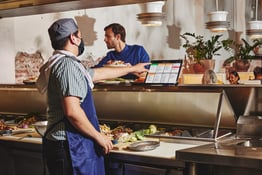As Remy Robotics CEO Yegor Traiman sees it, the future of restaurant robotics lies in building more flexible technology. Hardware-based solutions built for repeating one-off tasks, like flipping burgers, aren’t sustainable, he says, and kitchens need to be built for the robot, rather than the other way around.
“The biggest mistake you can make is to try to teach robots to cook in the way humans cook – they're not good at that,” says Traiman. “In a world where everything was designed and built by humans, for humans, there’s little place for robots, so you must build the entire framework, meaning the cooking tools and the recipes, around the robots and for the robots.”
Traiman launched Barcelona-based Remy Robotics in 2018, and the company now operates several robot-powered dark kitchens in Barcelona and Paris. The kitchens operate based off of algorithmic cooking, which uses machine-to-machine communication between the company’s own smart ovens, fridges, and robotic arms. Traiman says the company’s robotic technology is built to autonomously evaluate certain factors, like cooking methods and how long to cook a dish, that enable meals to be cooked to precision. It also uses “computer vision and neural networks”, along with “sensors controlling temperature, moisture, weight and other key parameters” to assure quality.
Currently, under its own in-house virtual brands, Remy Robotics offers delivery food ranging from Indian cuisine to chicken wings to marinated salmon to vegan Chinese. Its AI-powered technology is capable of producing over 100 recipes. The company says it’s sold over 70,000 meals through delivery platforms like Uber Eats and Deliveroo and holds a return customer rate of over 40%.
The short-term goal is to continue to build that customer base, but the future plan is to franchise the technology to other restaurant operators. We sat down with Traiman to learn more about how the technology works and where he sees industry robotics continuing to evolve.
type: embedded-entry-inline id: 3p9cyHjjXzcYrhnR7BW9nj
I’d love to start out learning a little more about your background. How did you first get into the robotics field and what drew you specifically to the food service industry?
I’m a software engineer by education. This is my third, high-tech innovative startup. My most recent project was an electrical automotive startup, where I became familiar with robotics, where I became familiar with robotics, learning the main difference between traditional industrial robotics and what's called adaptive robotics. It’s the next evolution, based on the recent advances in robotics and AI.
I left the company because I saw a much bigger potential of applying flexible adaptive robotics in food service. This space has a huge problem related to labor shortage, and robotics seems to be a self-evident solution, but unfortunately, we haven't seen market adoption. There are several projects, but they can hardly be named as widely used solutions. My initial vision was to start applying these new types of robotics to this very demanding space.
Can you share more about what you mean by flexible adaptive robotics and how you’re putting that into practice?
For decades, robots have been mainly known for their industrial applications. The most obvious example is automotive conveyor-based automation, where you'd be very specific – a robotic solution developed around one specific type of car model. There’s a huge factory, which produces millions of vehicles across a long period of time, using robots that are hardware-driven. Once built, the robots can’t be changed, and they’re mainly dealing with very physically demanding tasks.
Now, let's come back to food service. It's completely different. Instead of having hundreds of car models, you have millions of recipes, and thousands of restaurant designs that have specific requirements. If you start applying the same [industrial] methods, what do you get? You get a container-type or vending-machine-type of robotics that can cook just one single type of food at a time, like pizza. Companies start with these solutions because at the end of the day, every hardware solution is easier to [build] compared to artificial intelligence. But it's very difficult to scale because it's inflexible and expensive. Container-type solutions cost several $100,000, and all startups which are trying to apply them count on economy of scale, but it's very, very hard.
In our case, instead of building a purpose-built solution around some specific type of food, like pizza, we've built a specific cooking framework around the robots, which allows us to cook almost unlimited types of food. This is what the food industry requires.
Our approach is a combination of culinary engineering and food science, plus flexible adaptive robotics. The culinary engineering team develops recipes based on specific parameters, like how much moisture is lost during the cooking process, the shape of our packaging, and cooking that happens in the packaging during delivery. Our robotic kitchens are software-defined and therefore can be easily adapted to different, unstructured environments. There is no need to build a new solution every time you want to do something different, and our kitchens can be deployed and scaled fast.
Can you give me an example of what the meal process looks like at one of your dark kitchens?
In our case, you won't see a robot flipping burgers. We use robots for very, very precise cooking. The culinary engineering team takes a huge amount of data to make a recipe digital, meaning to let robots dynamically build a cooking formula.
So take salmon – it’ll get sous vide at a central kitchen. Then it will be packaged in a special package and delivered to a dark kitchen. When an order comes, the robots know the exact weight of the salmon, and multiple cooking parameters are set accordingly. We’ll cook it from the sous vide state up to the final state, but believe it or not, we leave a considerable amount of cooking time for when it’s inside the package.
The packaging – smart, on-purpose packaging – is not just packaging for us but also a cooking tool. The robots cook differently depending on how far away the food needs to be delivered, whether that’s five minutes or 20 minutes, to make the cooking precise. It’s just like with meat, for example. Medium or rare, robots can do precision much better than humans.
So the cooking starts with humans at a commissary kitchen, and automated technology finishes it off. Do you think humans are always going to be an important part of the equation?
I’ve dedicated all of my life to disruptive technologies, so I don’t want to say “always”. But Star-Wars-[like] robots are very far away from now.
It’s like any QSR. No one cooks from start to finish at the restaurant. It's mainly the final cooking, while most of the cooking is done at a commissary kitchen or directly supplied from external suppliers. And this is how I see the future of this space.
Robots are not able to manipulate different shapes and textures. You can teach a robot to cut a cut and grasp a cucumber. But if tomorrow, you want it to do the same with a tomato, it’ll take an additional year of R&D. We have a central kitchen, and multiple locations where the robots do the final cooking. Without collaboration, where humans do some prep, there’s not a commercially viable solution.
type: embedded-entry-inline id: 45ik4FlqqCkDnYOJOPOjxu
Do you envision Remy Robotics entering a world beyond the delivery realm in the future?
We started [with dark kitchens] because I really believe in food delivery. I see and believe that the younger generation doesn’t want to cook.
On the other hand, most virtual restaurants are struggling. The idea sounds amazing – you can create a bunch of digital virtual brands and save on labor and not needing a prime location. But because of the high cost of delivery and marketing, it’s not sustainable.
To break even, you need to sell 60 to 70 orders a day, on average, from one location. To have a decent unit economics, you need to sell close to 150 orders a day. But it's extremely hard to stand out and differentiate yourself among thousands of restaurants on a delivery platform. Then you have a problem of inconsistency. The labor shortage problem is even more evident in this space – cooks don't want to work in dark kitchens. And from the customer point of view, even after the pandemic, the experience is still unpredictable and expensive, and so you can’t use it as a substitute for home cooking.
So delivery is an amazing sector because technology can bring a lot to a space that’s not yet sustainable. I’m not unique here – I know many of my fellow colleagues will say, we don't expect robots to come into fine-dining. We humans come to fine dining to get emotions, and emotions don't come from robots. The level of attention to details that fine dining requires is also unachievable for robots at the time being. So that's why we started with food delivery.
I’d love to hear about your future goals for Remy and where you see your technology continuing to advance.
We believe we can be the only franchisable virtual restaurant of this kind right now due to the complexity of the space. I also think B2B with QSR restaurant groups might give us more potential than only B2C, but B2B always takes time. We already have several ongoing pilots. And we’ll keep pursuing both directions.
This interview has been edited for length and clarity.
Grace Dickinson is a reporter at Back of House. Send tips or inquiries to grace@backofhouse.io.





